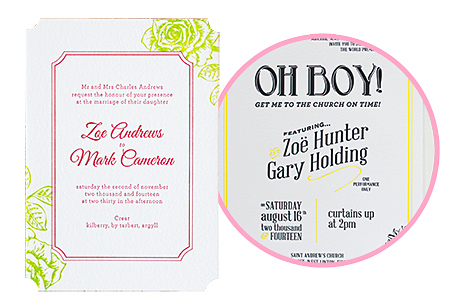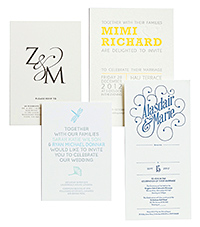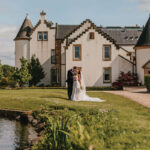In this social media-obsessed age, getting a wedding invite in the post is a real treat. Here’s how to set the right tone with yours…

Words by Beth Forsyth
First impressions count, especially when it comes to wedding stationery. “As your guests open the invitation, they should be presented with the style of your wedding, be it traditional, vintage or contemporary,” notes Gemma Pearce of Nairn-based Piccolo Press (piccolopress.co.uk). Although as with many things wedding-related, the bewildering level of choice doesn’t always make it straightforward, as Gemma points out. “With such a wide range of options, deciding what is best to reflect your theme can be difficult. You must take into account quality, decoration, material and lettering.”
MATERIAL GIRL
The card or paper you choose to print your invite on will send out signals to your soon-to-be guests, as Gemma sets out. “Printing your invitations on thick card will give your wedding a sense of sophistication as well as style. For a more contemporary feel, invitations can be printed on more modern materials such as Perspex, vinyl and fabric. With so many paper colours, textures and weights to chose from, as well as inks, fonts, print techniques and finishes, you can be totally creative.”
THINK FONTS
There are no strict guidelines when it comes to fonts (typefaces) for your wedding stationery. However, Gemma recommends choosing a font that not only complements the invitation but also mirrors the styling of the wedding itself. “If you are undecided about what font to select, we can help you narrow the list down by writing your names in the fonts chosen. You may find that you dislike the font once you see it used for your names.”
OH MY WORD
Lyndsey Hunter of letterpress studio The Hunter Press (thehunterpress.co.uk) stresses that the wording that you choose is also very important as it communicates the tone of your day. “There are two main directions; traditional wedding etiquette or something a little more modern and individual.” Invites in the traditional vein will usually open with the hosts’ names at the top (be it the bride’s parents, groom’s parents, both sets of parents, or, indeed, the couple themselves); names will be written in full and there will be no abbreviations. “For the more casual bride and groom the possibilities are endless. The decision may be to avoid the conventional wording and opt for something a little lighter,” she adds.


TO DIY OR NOT?
Armed with a scalpel and glue gun , some brides-to-be relish the prospect of getting crafty and making their own stationery. Sure, it can be fun, but Lyndsey points out that “designing your own stationery can be a daunting task and can add quite a bit of extra stress to your wedding planning.”
“Beautiful handcrafted stationery leaves a lasting impression which is unrivalled by flat, untextured digital print,” maintains Gemma. Indeed, there are some methods used to make stationery that it would be nigh-on impossible to recreate at home. Take letterpress for example. “It is a very unique and tactile print method that cannot be recreated using digital methods,” explains Lyndsey. “At Hunter Press, it’s a real labour of love, from the hand-mixing of the inks to running each colour through the vintage Heidelberg presses one at a time. The result is something truly beautiful and there really is no comparison.”
THE RIGHT TIMING
Lyndsey suggests planning your stationery “at least five months prior to your big day, allowing a minimum of two months for design and print,” noting that letterpress printing is a much longer process than digital printing. “On average, a print-only job will take up to four weeks for completion,” although this time is significantly increased when working on bespoke designs.
At Piccolo Press, Gemma says it can take anything from 10 days to three weeks from the sign off of the design/quote, to getting the finished invites back, although “timings will depend on the complexity of the print process and finishes chosen”.
Ideally, you should aim to send out your invites at least eight weeks prior, with an RSVP date of two-to-three weeks before your big day to allow ample time for guests to respond and for you to tot up final figures.








